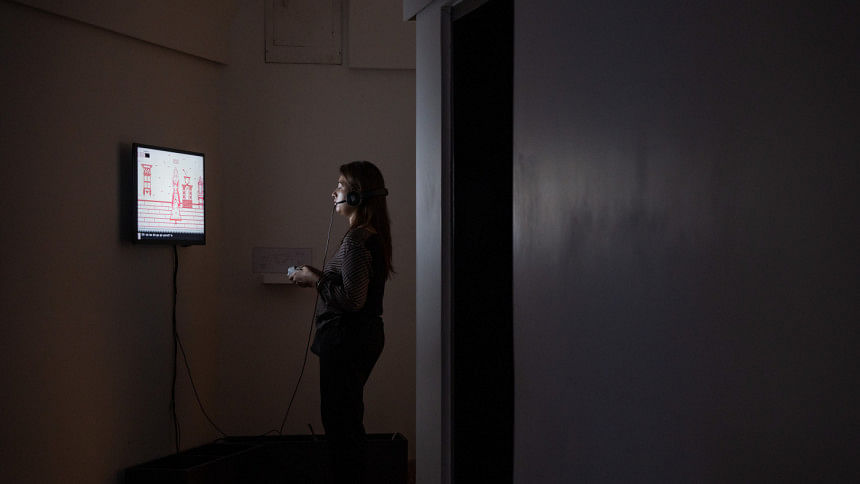Where the spirit meets the bone: A multisensory exhibition to soothe your soul

A multisensory exhibition, titled "Where the Spirit Meets the Bone", is currently on display at Satori Academy of Arts in the capital's Banani. This striking exhibit attempts to explore the many layers of human emotions -- from personal wounds to global issues, intimate loss and grief of rediscovering inner self -- through an interplay of sensory cues like touch, sound, or scent.
The showcase is taking place in two parts, with the first chapter commencing on April 25. The event has been organised by LUX and Art South Asia Projects.
The event's curator, Kehkasha Sabah, highlighted that this show blends traditional elements with technology to evoke unexpressed human emotions.
"Hosted at the Satori Foundation, a meditation centre known for its tranquil environment, the exhibition aligns deeply with mindfulness and resilience," reflected Sabah. In her words, the serene setting allows audiences to escape from the chaos of city life and engage fully with the artworks -- offering a space to simply sit down and observe.
The event opened with a live performance by Sharad Das, captivating the audience with his handmade musical instruments crafted from the severed trees near his home, which were once homes to thousands of birds -- now all extinct.
"The performance is inspired by the confrontation between human lust and the very nature he is born into," observed Das. His sculptural series, titled "The Hand that Kills, The Hand that Mourns", resonates the sentiment. "We erase the nature and then weep its loss. It is on us to let it heal," Das explained.
Following the performance, Sabah led the visitors for a curatorial walk. Inside the house, the audience was immediately charmed by various art installations created by Afrah Shafiq, Naeem Mohaiemen, Reetu Sattar, Sounak Das, and Yasmin Jahan Nupur, among many others. The artworks ranged from interactive video games, soundscapes, video projections, film and mixed media installations.
A sensational work from the show was "Je Dak Kothao Pouche Na" (Calls that Reach Nowhere) by artist and filmmaker Reetu Sattar. The work featured 6-channel videos, with sounds featuring clapping hands, (turi) ulu chants, rhythmic thumping of feet, etc -- each of the tunes coming together as a haunting chant.
"The 'besura' [distune] or 'betala' [no rhythm] and the anonymity of the performers resist the politics of erasure, emerging as a unified voice of resistance," suggests the artist.

According to her, this work explores the psyche of marginalised communities whose voices are barely ever heard.
Visitors seemed to be moved by the immersive show. "For me, 'The Last Breath Spoken' was a showstopper," contemplated Fahmida Alam, a fine arts student who was in attendance. "The scent, sounds and the atmosphere were truly soothing," she added.
Sabah, an independent curator, writer, and researcher, remarked that the exhibition emphasises sensory and temporal dimensions, and they are marked by fracture and survival. The show focused on producing narratives of empathy, as she further adds, "Each piece is kinaesthetic and meditative, and they speak of healing and care."
Installations like "Lowlands" by Susan Philipsz, "Don't Look at the Finger" by Hetain Patel, and "The Bride Who Could Not Stop Crying" by Afrah Shafiq, deeply connected with the audience with the creative use of digital media, creating a new dialogue in the contemporary art scene.
The second chapter of the event is set to commence on May 9. The show is taking place in collaboration with the British Council, and is open daily from 11:00am to 8:00pm.

 For all latest news, follow The Daily Star's Google News channel.
For all latest news, follow The Daily Star's Google News channel. 



Comments